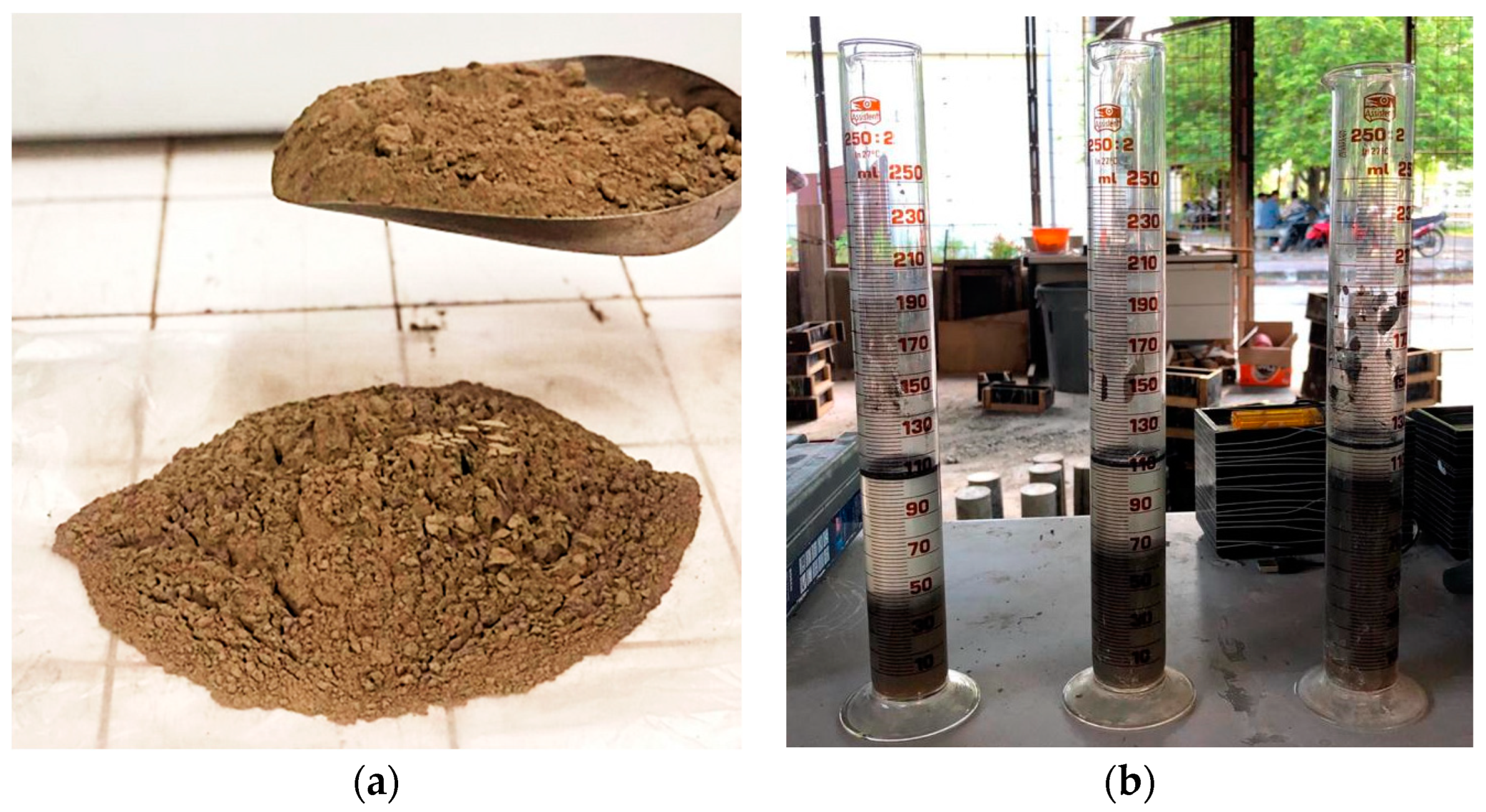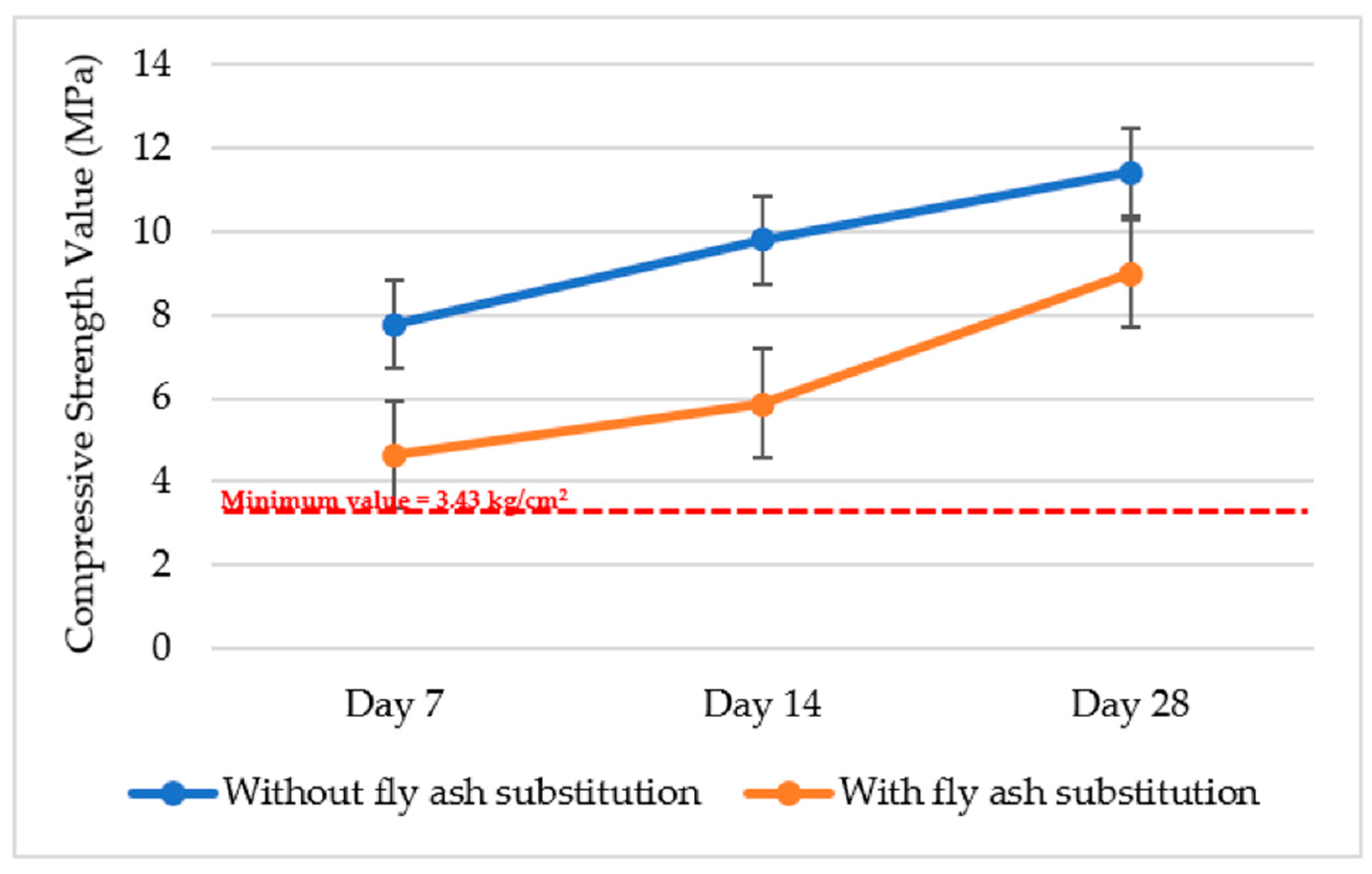Fly Ash Substitution in Lightweight Concrete for Rigid Pavement Construction on Low-Bearing-Capacity Soil
Abstract
:1. Introduction
2. Materials and Methods
3. Results
4. Discussion
5. Conclusions
Author Contributions
Funding
Institutional Review Board Statement
Informed Consent Statement
Data Availability Statement
Conflicts of Interest
References
- White, G. Comparing the Cost of Rigid and Flexible Aircraft Pavements Using a Parametric Whole of Life Cost Analysis. Infrastructures 2021, 6, 117. [Google Scholar] [CrossRef]
- Mallick, R.B.; El-Korchi, T. Pavement Engineering: Principles and Practice; CRC Press: Boca Raton, FL, USA, 2009; pp. 1–35. [Google Scholar]
- Papagiannakis, A.; Masad, E. Pavement Design and Materials; John Wiley & Sons, Inc.: Hoboken, NJ, USA, 2008. [Google Scholar]
- Gosse, C.A.; Smith, B.L.; Clarens, A.F. Environmentally Preferable Pavement Management Systems. J. Infrastruct. Syst. 2012, 19, 315–325. [Google Scholar] [CrossRef]
- Hamim, O.F.; Aninda, S.S.; Hoque, M.S.; Hadiuzzaman, M. Suitability of Pavement Type for Developing Countries from An Economic Perspective Using Life Cycle Cost Analysis. Int. J. Pavement Res. Technol. 2020, 14, 259–266. [Google Scholar] [CrossRef]
- Khahro, S.H.; Memon, Z.A.; Gungat, L.; Yazid, M.R.; Rahim, A.; Mubaraki, M.; Yusoff, N.I. Low-Cost Pavement Management System for Developing Countries. Sustainability 2021, 13, 5941. [Google Scholar]
- Lee, J.L.; Chen, D.H.; Ishikawa, T. Sustainability on Pavement Engineering. Int. J. Pavement Res. Technol. 2017, 9, 403–404. [Google Scholar] [CrossRef]
- Zhang, R.; Tang, N.; Zhu, H.; Zeng, J.; Bi, Y.; Xi, Y. Environmental and Economic Comparison of Semi-Rigid and Flexible Base Asphalt Pavement during Construction Period. J. Clean. Prod. 2022, 340, 130791. [Google Scholar] [CrossRef]
- Naik, C.S.; Sachdeva, S.N. Economy of Flexible and Rigid Pavements with Variation in Subgrade Strength and Traffic. Int. J. Adv. Res. Sci. Eng. 2017, 6, 430–434. [Google Scholar]
- Virsis, E.; Paeglitis, A.; Zarins, A. Road Design on Low Bearing Capacity Soils. Balt. J. Road Bridge Eng. 2020, 15, 19–33. [Google Scholar] [CrossRef]
- Gaile, Z.V.; Teppand, T.; Kriipsalu, M.; Krievans, M.; Jani, Y.; Klavins, M.; Setyobudi, R.H.; Grinfelde, I.; Rudovica, V.; Tamm, T.; et al. Towards Sustainable Soil Stabilization in Peatlands: Secondary Raw Materials as an Alternative. Sustainability 2021, 13, 6726. [Google Scholar]
- O’Mahony, M.J.; Owende, P.; Ward, S. Bearing Capacity of Forest Access Roads Built on Peat Soils. J. Terramechanics 2000, 37, 127–138. [Google Scholar] [CrossRef]
- Correia, A.G.; Winter, M.G.; Puppala, A.J. A Review of Sustainable Approaches in Transport Infrastructure Geotechnics. Transp. Geotech. 2016, 7, 21–28. [Google Scholar]
- Guyer, J.P. An Introduction to Road Design for Cold Regions, 2nd ed.; The Clubhouse Press: San Carlos, CA, USA, 2018. [Google Scholar]
- Pan, Z.; Li, H.; Liu, W. Preparation and Characterization of Super Low Density Foamed Concrete from Portland Cement and Admixtures. Constr. Build. Mater. 2014, 72, 256–261. [Google Scholar] [CrossRef]
- Amran, Y.M.; Farzadnia, N.; Ali, A.A. Properties and Applications of Foamed Concrete: A Review. Constr. Build. Mater. 2015, 101, 990–1005. [Google Scholar]
- Abdullah, A.; Bustari, B.; Fonna, S. Pengembangan Beton Ringan Mutu Tinggi Dengan dan Tanpa Serat; Universitas Syiah Kuala: Banda Aceh, Indonesia, 2018. [Google Scholar]
- Suryani, F.M.; Rizal, S.; Abdullah, A.; Isya, M. Lightweight Concrete in Cement-Treated Subbase Construction. IOP Conf. Ser. Mater. Sci. Eng. 2021, 1087, 012038. [Google Scholar] [CrossRef]
- Saodang, H. Konstruksi Jalan Raya: Perancangan Perkerasan Jalan Raya; Penerbit Nova: Bandung, Indonesia, 2005. [Google Scholar]
- Jones, M.R.; Zheng, L.; Yerramala, A.; Rao, K.S. Use of Recycled and Secondary Aggregates in Foamed Concrete. Magaz. Concr. Res. 2012, 64, 513–525. [Google Scholar] [CrossRef]
- Jones, M.R.; Ozlutas, K.; Zheng, L. High-Volume, Ultra-Low-Density Fly Ash Foamed Concrete. Magaz. Concr. Res. 2017, 69, 1146–1156. [Google Scholar]
- Rashad, A.M. An exploratory study on high-volume fly ash concrete incorporating silica fume subjected to thermal loads. J. Clean. Prod. 2015, 87, 735–744. [Google Scholar] [CrossRef]
- Rana, A.; Sharma, A.; Jassal, K. Design of Rigid Pavement by Self Cured Concrete Utilizing Coarse Fly Ash Aggregates and Curing Admixture. IOP Conf. Ser. Earth Environ. Sci. 2021, 889, 012011. [Google Scholar] [CrossRef]
- Kearsley, E.P.; Wainwright, P.J. The Effect of High Fly Ash Content on The Compressive Strength of Foamed Concrete. Cem. Concr. Res. 2001, 31, 105–112. [Google Scholar] [CrossRef]
- Direktorat Jenderal Bina Marga. Spesifikasi Umum 2018 untuk Pekerjaan Konstruksi Jalan dan Jembatan; Kementerian Pekerjaan Umum dan Perumahan Rakyat: Jakarta, Indonesia, 2018. [Google Scholar]
- Direktorat Jenderal Bina Marga. Manual Desain Perkerasan Jalan; Kementerian Pekerjaan Umum dan Perumahan Rakyat: Jakarta, Indonesia, 2017. [Google Scholar]
- Tiwari, B.; Ajmera, B.; Maw, R.; Cole, R.; Villegas, D.; Palmerson, P. Mechanical Properties of Lightweight Cellular Concrete for Geotechnical Applications. J. Mater. Civ. Eng. 2017, 29, 7. [Google Scholar]
- Badan Standarisasi Nasional. Metode Pengujian Kuat Tekan Beton (SNI 03-1974-1990); Badan Standarisasi Nasional: Jakarta, Indonesia, 1990. [Google Scholar]
- Chen, B.; Liu, N. A Novel Lightweight Concrete-Fabrication and Its Thermal and Mechanical Properties. Constr. Build. Mater. 2013, 44, 691–698. [Google Scholar]
- Ni, F.M.; Oyeyi, A.G.; Tighe, S. The Potential Use of Lightweight Cellular Concrete in Pavement Application: A Review. Int. J. Pavement Res. Technol. 2020, 13, 686–696. [Google Scholar]
- Badan Standarisasi Nasional. Metode Pengujian Kuat Lentur Normal dengan Dua Titik Pembebanan (SNI 03-4431-1997); Badan Standarisasi Nasional: Jakarta, Indonesia, 1997. [Google Scholar]
- Hayati, R. Pengaruh Abu Terbang (Fly Ash) Sebagai Bahan Pengganti Semen Terhadap Sifat Mekanis Beton Busa (Foamed Concrete); Universitas Syiah Kuala: Banda Aceh, Indonesia, 2014. [Google Scholar]
- Mulyono, T. Teknologi Beton; Andi: Yogyakarta, Indonesia, 2004. [Google Scholar]
- Salain, I.M.; Sutarja, N.; Eryantha, A.A. Kuat Tekan Beton yang Menggunakan Abu Terbang sebagai Pengganti Sebagian Semen Portland dan Agregat Kasar Batu Kapur Kristalin. In Konferensi Nasional Teknik Sipil 8 (KoNTekS8); Institut Teknologi Nasional: Bandung, Indonesia, 2014. [Google Scholar]
- Suarnita, I.W. Kuat Tekan Beton dengan Aditif Fly Ash Ex. Pltu Mpanau Tavaeli. J. SMARTek 2011, 9, 1–10. [Google Scholar]
- Ahmaruzzaman, M. A review on the utilization of fly ash. Prog. Energy Combust. Sci. 2010, 36, 327–363. [Google Scholar]
- Femandez-Jimenez, A.; Palomo, A. Microstructure development of alkali-activated fly ash cement: A descriptive model. Cem. Concr. Res. 2005, 35, 1204–1209. [Google Scholar] [CrossRef]
- Gong, Y.; Yang, J.; Sun, H.; Xu, F. Effect of Fly Ash Belite Cement on Hydration Performance of Portland Cement. Crystals 2021, 11, 740. [Google Scholar]
- Rashad, A.M. A brief on high-volume Class F fly ash as cement replacement—A guide for Civil Engineer. J. Clean. Prod. 2015, 4, 278–306. [Google Scholar]
- Rashad, A.M.; Zeedan, S.R. The effect of activator concentration on the residual strength of alkali-activated fly ash pastes subjected to thermal load. Constr. Build. Mater. 2011, 25, 3098–3107. [Google Scholar] [CrossRef]
- Rashad, A.M. Investigation on high-volume fly ash pastes modified with micro-size metakaolin subjected to high temperatures. J. Cent. South Univ. 2020, 27, 231–241. [Google Scholar]
- IPCC. Intergovernmental panel on climate change, 4th Assessment report. In Assessment of Observed Changes and Responses in Natural and Managed Systems, Climate Change 2007: Impacts, Adaption and Vulnerability, Contribution of Working Group II to the 4th Assessment Report of the Intergovernmental Panel on Climate Change; Parry, M.L., Ed.; Cambridge University Press: Cambridge, UK, 2007; pp. 79–131. [Google Scholar]
- Salahuddin, K.M.; Izadifar, M.; Ukrainczyk, N.; Koenders, E.; Middendorf, B. Dissolution of β-C2S Cement Clinker: Part 1 Molecular Dynamics (MD) Approach for Different Crystal Facets. Materials 2022, 15, 6388. [Google Scholar] [CrossRef]
- Izadifar, M.; Ukrainczyk, N.; Salahuddin, K.M.; Middendorf, B.; Koenders, E. Dissolution of β-C2S Cement Clinker: Part 2 Atomistic Kinetic Monte Carlo (KMC) Upscaling Approach. Materials 2022, 15, 6716. [Google Scholar] [CrossRef] [PubMed]
- Flower, F.; David, J.M.; Sanjayan, J.G. Green house gas emissions due to concrete manufacture. Int. J. LCA 2007, 12, 282–288. [Google Scholar] [CrossRef]
- Jelušič, P.; Gücek, S.; Žlender, B.; Gürer, C.; Varga, R.; Bračko, T.; Taciroğlu, M.V.; Korkmaz, B.E.; Yarcı, Ş.; Macuh, B. Potential of Using Waste Materials in Flexible Pavement Structures Identified by Optimization Design Approach. Sustainability 2023, 15, 13141. [Google Scholar] [CrossRef]



| Fly Ash Sample | Sample Weight | Water Level Increase | Specific Gravity |
|---|---|---|---|
| (gr) | (mL) | ||
| A | 20 | 8 | 2.5 |
| B | 30 | 12 | 2.5 |
| C | 50 | 20 | 2.5 |
| Tests | Configuration | Specimen | Concrete Age | Quantity |
|---|---|---|---|---|
| (Days) | ||||
| Compressive Strength | Cylinders 150 × 300 mm | Without fly ash substitution | 7 | 3 |
| 14 | 3 | |||
| 28 | 3 | |||
| With fly ash substitution | 7 | 3 | ||
| 14 | 3 | |||
| 28 | 3 | |||
| Flexural Strength | Prisms 150 × 150 × 600 mm | Without fly ash substitution | 7 | 3 |
| 14 | 3 | |||
| With fly ash substitution | 7 | 3 | ||
| 14 | 3 |
| Specimen Age | Specimen Number | Compressive Strength (MPa) | |
|---|---|---|---|
| (Days) | Unit | Average | |
| 7 | 1 | 6.07 | 7.77 ± 1.63 1 |
| 2 | 7.92 | ||
| 3 | 9.32 | ||
| 14 | 1 | 9.80 | 9.79 ± 0.40 |
| 2 | 10.19 | ||
| 3 | 9.39 | ||
| 28 | 1 | 11.05 | 11.41 ± 0.40 |
| 2 | 11.85 | ||
| 3 | 11.33 | ||
| Specimen Age | Specimen Number | Compressive Strength (MPa) | |
|---|---|---|---|
| (Days) | Unit | Average | |
| 7 | 1 | 5.00 | 4.65 ± 0.31 1 |
| 2 | 4.48 | ||
| 3 | 4.46 | ||
| 14 | 1 | 5.76 | 5.88 ± 0.16 |
| 2 | 6.06 | ||
| 3 | 5.83 | ||
| 28 | 1 | 9.61 | 8.99 ± 0.58 |
| 2 | 8.91 | ||
| 3 | 8.46 | ||
| Specimen Age | Specimen Number | (MPa) | |
|---|---|---|---|
| (Days) | Unit | Average | |
| 7 | 1 | 0.95 | |
| 2 | 0.84 | 0.93 ± 0.08 1 | |
| 3 | 0.99 | ||
| 28 | 1 | 1.69 | |
| 2 | 1.72 | 1.77 ± 0.12 | |
| 3 | 1.91 | ||
| Specimen Age | Specimen Number | (MPa) | |
|---|---|---|---|
| (Days) | Unit | Average | |
| 7 | 1 | 0.88 | |
| 2 | 0.84 | 0.75 ± 0.19 1 | |
| 3 | 0.54 | ||
| 28 | 1 | 1.42 | |
| 2 | 1.53 | 1.45 ± 0.08 | |
| 3 | 1.39 | ||
Disclaimer/Publisher’s Note: The statements, opinions and data contained in all publications are solely those of the individual author(s) and contributor(s) and not of MDPI and/or the editor(s). MDPI and/or the editor(s) disclaim responsibility for any injury to people or property resulting from any ideas, methods, instructions or products referred to in the content. |
© 2023 by the authors. Licensee MDPI, Basel, Switzerland. This article is an open access article distributed under the terms and conditions of the Creative Commons Attribution (CC BY) license (https://creativecommons.org/licenses/by/4.0/).
Share and Cite
Suryani, F.M.; Rizal, S.; Abdullah, A.; Isya, M. Fly Ash Substitution in Lightweight Concrete for Rigid Pavement Construction on Low-Bearing-Capacity Soil. Sustainability 2023, 15, 15239. https://doi.org/10.3390/su152115239
Suryani FM, Rizal S, Abdullah A, Isya M. Fly Ash Substitution in Lightweight Concrete for Rigid Pavement Construction on Low-Bearing-Capacity Soil. Sustainability. 2023; 15(21):15239. https://doi.org/10.3390/su152115239
Chicago/Turabian StyleSuryani, Fitrika Mita, Samsul Rizal, Abdullah Abdullah, and M. Isya. 2023. "Fly Ash Substitution in Lightweight Concrete for Rigid Pavement Construction on Low-Bearing-Capacity Soil" Sustainability 15, no. 21: 15239. https://doi.org/10.3390/su152115239
APA StyleSuryani, F. M., Rizal, S., Abdullah, A., & Isya, M. (2023). Fly Ash Substitution in Lightweight Concrete for Rigid Pavement Construction on Low-Bearing-Capacity Soil. Sustainability, 15(21), 15239. https://doi.org/10.3390/su152115239






